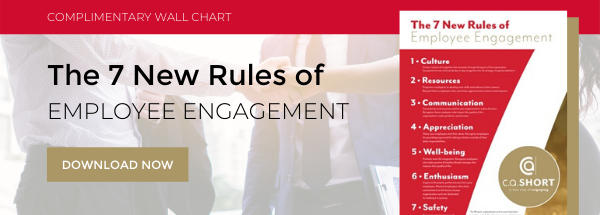Are You Maximizing Employee Well-being?

This blog post is the 6th in a series of posts about creating high-performance teams.
Earlier this week, and as we continue to dive into the 7 NEW Rules of Employee Engagement, we explored the topic of appreciation and the benefits of employees appreciation.Today, we speak to the well-being of your employees and how rewarding the well-being of your employees will benefit your organization.
Rule #5 WELL-BEING:
Promote work-life integration. Recognize employees who make positive & healthy lifestyle changes that improve the quality of life.
Impact of Employee Well-being in the Workplace
 Employee well-being, at a glance, is quite simple: Ensure that your employees are happy at work. But is it really that simple?
Employee well-being, at a glance, is quite simple: Ensure that your employees are happy at work. But is it really that simple?
If you dive deeper into the concept of well-being, you will note that it's truly about personal happiness; individuals feeling good, working safely, and being healthy. A study conducted by Towers Watson shows that work environments, where well-being is part of the company culture, and where there is a strong leadership initiative to recognize employee performance, enjoy an engagement increase of almost 60%!
Companies that have a sustainable well-being program experience less turnover, lower insurance claims, and greater job satisfaction, which directly impacts overall productivity. In short, healthy employees don’t leave. A further study by Towers Watson and the National Business Group on Health shows that organizations with highly effective wellness programs report significantly lower voluntary attrition than programs that have low effectiveness (9% vs 15%).
In order for a well-being program to be successful it must:
- Foster engagement
- Be motivating
- Offer support
- Link to the overall organizational recognition strategy
Well-being vs. Wellness of Employees
We often use the terms well-being and wellness interchangeably, but there is a distinct difference. Well-being is more of a holistic, whole life experience, whereas wellness refers more closely to physical health. Both are acutely important, and they can run concurrently, but recognizing the difference can be a key to the success of an organizational strategy or program.
Well-being programs show employees that the company supports them, not just the work they produce. Employee wellness programs transfer the ownership directly to the employee. If the employee puts forth effort to adhere to the wellness program, the employee is rewarded. Well-being programs transfer the ownership back to the employer.
Look at it as, “we will scratch your back so you will scratch our back." HR is shifting as this understanding grows. Prior to spending money on learning and development, talent management and retention of staff are now investing in the health and well-being of their employees as a more important HR function.
Looking for some quick wins?
- Implement a recognition program to reward employees who participate in wellness challenges, yearly health checks, volunteering days, or the like.
- Consider work-life balance schedules. Offer extended time off to employees who participate in projects that require extensive overtime.
- Offer job share, part-time, and flex-time schedules to those with a significant commute to the office.
- Offer positive mind & body activities and holistic therapies in the workplace to prevent stress and to reduce stress when it arises.
At C.A. Short Company, we are your partner for increased employee engagement resulting in increased performance outcomes to grow your bottom line. Our process and research-based platform help you engage your team in order to increase your bottom line, motivate your staff to the benefit of the entire organization and reward your people for the positive changes they make. To request a Complimentary Consultation, please click here.
